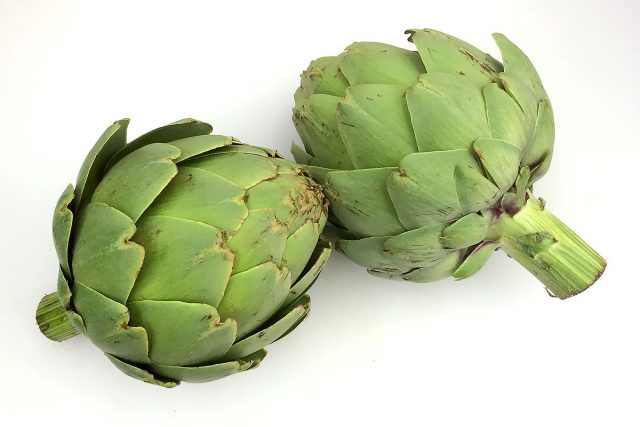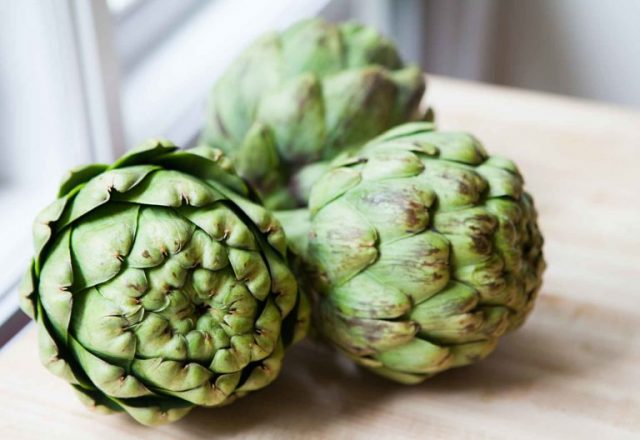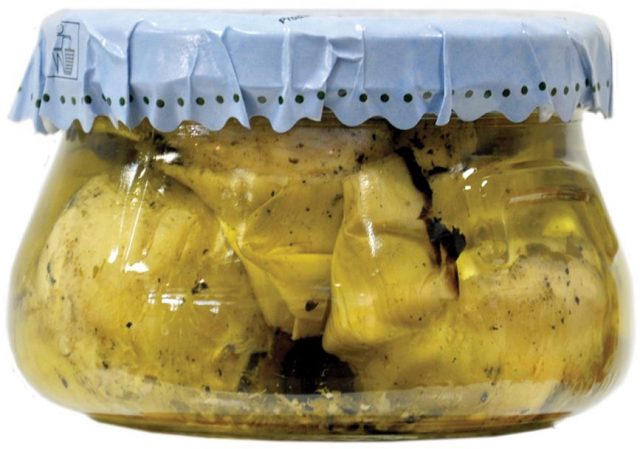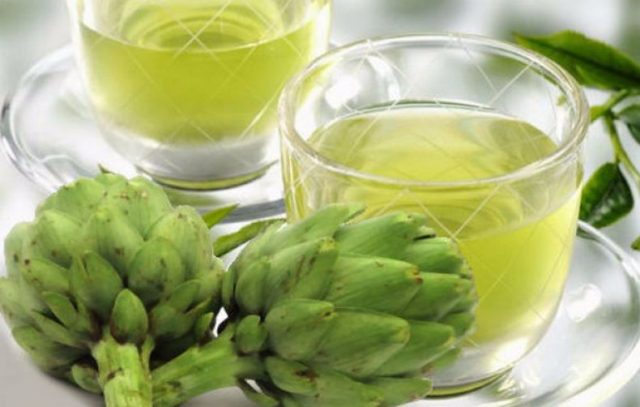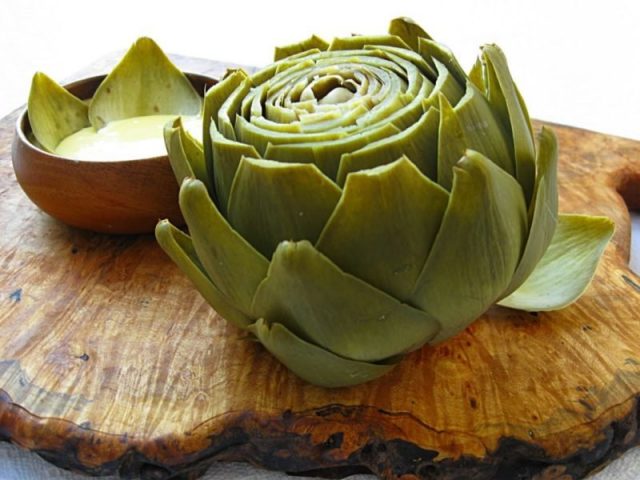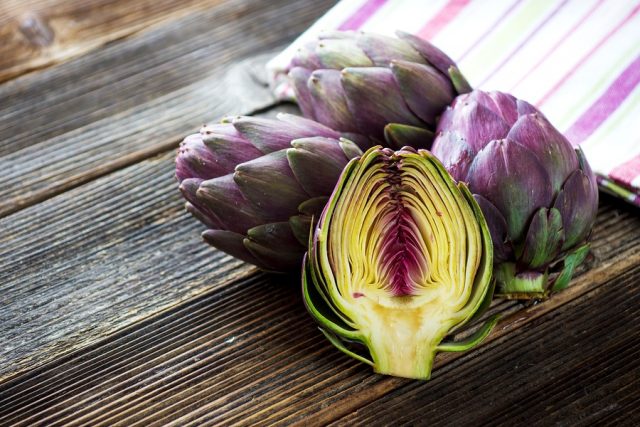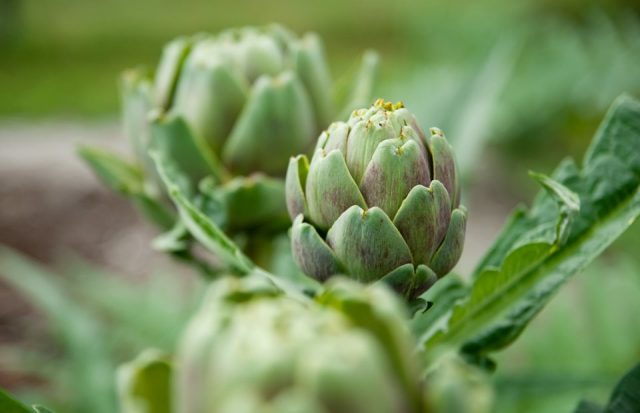Content
- 1 What are artichokes and what they look like
- 2 Artichoke composition
- 3 What does an artichoke taste like?
- 4 Which artichoke is better
- 5 Why artichoke is good for you
- 6 What does an artichoke heal?
- 6.1 Artichoke for the liver
- 6.2 Artichoke for edema
- 6.3 Artichoke for diabetes
- 6.4 Artichoke for gout
- 6.5 Artichoke for the kidneys
- 6.6 Artichoke for the gallbladder
- 6.7 Artichoke for cholesterol
- 6.8 Artichoke for endometriosis
- 6.9 Pancreas artichoke
- 6.10 Artichoke for potency
- 6.11 Stomach artichoke
- 6.12 Artichoke for prostatitis
- 6.13 Thyroid artichoke
- 6.14 Artichoke for the intestines
- 7 Is it possible for an artichoke to be pregnant
- 8 Is it possible for an artichoke for a nursing mother
- 9 Is it possible for children to have an artichoke
- 10 Could you be allergic to artichoke?
- 11 Contraindications to artichoke
- 12 How to take an artichoke medicinally
- 13 How to eat artichokes
- 14 Artichoke in cosmetology
- 15 How to take an artichoke for weight loss
- 16 Side effects of the artichoke
- 17 Calorie artichoke
- 18 How to store artichokes
- 19 How to replace an artichoke
- 20 Conclusion
- 21 Reviews of artichoke hosts
The artichoke is an exotic vegetable that is quite rare on the everyday table. But it is interesting to understand the benefits and dangers of the product, since the medicinal properties of the artichoke are very diverse.
What are artichokes and what they look like
From the point of view of botany, the product belongs to the Astrov family, it is a Compositae annual plant with large scaly buds. If you look at a photo of an artichoke during the flowering period, then it will look like an ordinary thistle, but much larger in size. The edible part of the plant is its unblown bud, which looks like a large green pine or hop cone. The size of the buds of an exotic plant can vary greatly - from the size of a walnut to a large orange.
In everyday life, the artichoke is often called a vegetable because it is actively consumed in food. But in fact, the buds belong to the edible flower. The area of origin of the artichoke is considered the Mediterranean and other warm regions; it grows mainly in Spain, Greece, Italy, France and America. Spain and France are world suppliers of buds.
Artichoke composition
The medicinal properties of the artichoke are determined by the composition of this plant - it contains many substances valuable for health. The buds include the following components:
- sodium and potassium;
- phosphorus and calcium;
- magnesium;
- a large amount of vitamin C;
- vitamins B3 and K;
- beta carotene;
- tannins and pectins;
- organic acids;
- substance inulin;
- pyridoxine and folic acid;
- starch and niacin.
The nutritional value of the buds is represented mainly by carbohydrates, they are contained in the plant about 10 g. Proteins occupy 3 g in the total volume, and only 0.15 g is allocated to the share of fats.
What does an artichoke taste like?
The buds have a rather unusual taste. Some people compare it to boiled cabbage or asparagus, others find it tastes like zucchini. However, most people agree that the buds have a distinct hint of walnut and herb on the palate.
Which artichoke is better
There are quite a few types of useful plants in nature.But only 2 of them are used for food - sowing, or Spanish artichoke, and prickly artichoke, or French.
In addition, there are different categories of edible buds by size. Large ones can reach the size of a large orange, and are processed mainly by cooking. Small artichokes rarely exceed the size of a chicken egg; it is customary to preserve them or cut them into salads. Which of the varieties is better depends on the individual preferences and goals of the buyer.
Why artichoke is good for you
The buds are appreciated not only for its unusual taste, but also for its many beneficial properties. If you consume the artichoke at least from time to time, the buds:
- relieve the symptoms of vitamin deficiency and fill the body with valuable vitamins and minerals;
- regulate bowel function, solve the problem of constipation and contribute to weight loss;
- help get rid of puffiness - the buds have diuretic properties and quickly remove excess fluids and toxins from the tissues;
- support the health of the liver - in official and folk medicine, the hepatoprotective properties of buds are widely known, it is very useful to use them with an increased load on the liver;
- will be able to relieve the symptoms of flatulence;
- improve the condition for colds and various inflammatory processes.
With the help of buds, you can carry out a soft and quick cleansing of the body, it is not for nothing that they are recommended to use for a hangover and food poisoning.
Benefits of artichoke leaves
In folk medicine, not only the receptacle of an unusual plant is used, but also its leaves. They contain no less valuable substances than the edible part of the buds, so the leaves also have pronounced healing properties. On their basis, it is customary to brew teas and infusions, which have the following beneficial effects on the body:
- increase muscle tone and increase energy reserves;
- help well with inflammatory processes of the urinary tract and kidneys;
- improve the functioning of the intestines and gallbladder;
- promote faster breakdown and assimilation of food;
- reduce blood glucose levels and have a beneficial effect in diabetes mellitus.
Products based on artichoke leaves are actively used in dietetics and cosmetology, as they improve the condition of the skin and contribute to the rapid loss of excess weight.
Why is artichoke extract useful?
A popular dietary supplement is an extract from edible buds, it is a concentrated extract of a useful flower. You can buy it in most pharmacies, and artichoke preparations are sold both in liquid form and in the form of tablets and powders.
The methods of using the drug depend on its form and are described in detail in the instructions. The benefit of the extract is that it helps in case of malfunctioning of the liver and disturbances in the outflow of bile. It is also prescribed to equalize cholesterol levels, to cleanse the body and restore bowel function after serious poisoning.
Useful properties of artichoke juice
The juice of fresh buds contains a large amount of flavonoids, antioxidants and vitamins, therefore it has powerful medicinal and cosmetic properties.
The use of artichoke juice is especially recommended for people who have to live permanently in a poor environment. The tool will benefit smokers and people with alcohol problems, the valuable properties of the juice are manifested in the weakening of potency in men.
The benefits of canned artichoke
The buds do not retain their freshness for long, so canned artichokes with an extended shelf life are much more often found on sale.These buds contain organic acids and folic acid, B vitamins and polyphenols, fiber and calcium.
Canned buds are beneficial for the musculoskeletal system and prevent the development of joint diseases. They also strengthen vision, normalize digestion and have a complex rejuvenating effect on the body. Due to their high oil and fiber content, they should be consumed in small quantities, but canned buds will bring undoubted health benefits as part of side dishes, stews and salads.
What does an artichoke heal?
Indications for the use of artichoke apply to many ailments. There are dozens of recipes that recommend using both plant-based pharmaceuticals and food artichoke as a culinary dish, in both cases the buds will have a healing effect.
Artichoke for the liver
For the treatment and purification of the liver from toxins, the leaves of the plant are most often used, on their basis, healing infusions are prepared. For example, the following recipe is popular:
- dry leaves are crushed in the amount of 2 small spoons;
- pour raw materials with a glass of hot water;
- kept closed for 10 minutes, and then filtered.
You need to drink the product three times a day on an empty stomach, half a glass.
Reviews about artichoke for the liver offer another useful tool - alcohol tincture. In this case, 50 g of dry leaves must be poured with a glass of alcohol and removed to infuse for 2 weeks. The finished tincture is consumed three times a day, 2 large tablespoons of the product must be diluted in 100 ml of water and drunk on an empty stomach.
Artichoke for edema
The diuretic properties of buds and leaves are respected. They contain potassium, which promotes the elimination of excess water, as well as the substance inulin, which absorbs excess fluid, toxins and toxins.
To get rid of edema, you can regularly eat the buds as part of your daily meals. If you need to fix the problem urgently, you can drink a simple infusion on the leaves for several days - half a glass three times a day. To prepare such a drink, you need to brew 2 small spoons of dried foliage in boiling water for 10 minutes.
Artichoke for diabetes
Artichoke vitamins and other valuable substances in its composition help to lower glucose levels. In the treatment of diabetes, buds are used in the following ways:
- consume 200 g of boiled buds every 3 days as part of regular food;
- take a medicinal infusion every day - 200 g of the product must be poured with a liter of boiling water, insisted for an hour, and then drink 100 ml three times a day.
It is recommended to continue the treatment with edible buds for no longer than 3 months. If desired, the course can be repeated, but before that it is necessary to take a break for at least a month.
Artichoke for gout
Since the buds remove from the body not only toxins and toxins, but also harmful salt deposits, their properties are in demand in the treatment of gout. Traditional medicine offers the following recipes:
- 200 g of fresh buds together with leaves are crushed in a meat grinder, mixed with 3 cloves of garlic and 20 g of honey, and then taken twice a day for a large spoon for 3 months;
- 500 g of buds are boiled for a quarter of an hour in 3 liters of water, then the softened buds are crushed and mixed with chopped burdock leaves, and then applied with a compress to the sore joint for half an hour.
Also, the remaining broth can be used to add to medicinal baths, they can be taken once a week for 2 months.
Artichoke for the kidneys
A diuretic artichoke can improve kidney function and stop inflammation. To prepare a remedy, pour boiling water over 2 small spoons of dry leaves, soak them for 10 minutes and filter. They drink such an infusion in the volume of half a glass three times a day, it is better to take the product on an empty stomach.
Artichoke for the gallbladder
The artichoke is a choleretic with a quick action, therefore it is recommended to use it in case of difficulties in the outflow of bile. About 2 small spoons of the dried foliage of the plant should be poured with 300 ml of hot water and held under the lid for 20 minutes. The filtered product is drunk twice a day, if desired, the drink is allowed to be diluted with honey to improve the taste.
Artichoke for cholesterol
The buds have a beneficial effect on blood vessels and reduce the level of bad cholesterol. For medicinal purposes, it is recommended to use boiled receptacles at least once a week. In addition, you can take the tincture:
- 250 g of fresh leaves are kneaded;
- pour raw materials with a liter of vodka;
- remove to infuse for 10 days, and then filter.
It is recommended to drink the product in a large spoonful twice a day.
Artichoke for endometriosis
A disease called endometriosis often occurs in women suffering from hormonal imbalances. In this situation, the cleansing properties of an edible plant come to the rescue, the buds remove excess hormones from the body and improve the functioning of the reproductive system.
With endometriosis, the buds are useful for food, but you can also take an extract of a medicinal plant. You can buy the hood at the pharmacy, the method of reception is described in the instructions. On average, the drug is consumed in small amounts throughout the month.
Pancreas artichoke
During the period of exacerbation of pancreatic ailments, for example, with pancreatitis, it is not recommended to take buds in any form. They will irritate the inflamed organ and aggravate the course of the disease.
However, consuming the buds is very useful as a prophylaxis for pancreatitis. They improve the production of enzymes and promote the rapid breakdown of food, protecting the pancreas from inflammation. Eating the buds once a week will significantly strengthen the pancreas and improve metabolism.
Artichoke for potency
The spiny artichoke is used to increase male strength. If you take a quarter glass of fresh juice daily in the morning and in the evening, libido will improve, and problems in the genital area will go away by themselves.
Stomach artichoke
The buds contain a lot of potassium and sodium - these substances are very useful for the stomach and are especially in demand with high acidity. The plant has an alkaline effect and reduces discomfort, therefore it is recommended to use it for chronic gastritis to improve digestive processes in a boiled form.
Artichoke for prostatitis
The buds have pronounced anti-inflammatory properties and bring relief from inflammation of the prostate gland. It is recommended to include them in a permanent diet, in addition, you can take pharmacy products based on buds, twice a year, in monthly courses in accordance with the instructions.
Thyroid artichoke
The buds help to normalize the hormonal background, therefore, they are allowed for use with hypothyroidism and other ailments of the thyroid gland. Benefits will be brought not only by pharmacy extracts and extracts, but also culinary dishes with an edible plant, for example, salad with fresh buds, carrots, Brussels sprouts and low-fat ham.
Artichoke for the intestines
The buds contain a large amount of fiber, so they have an excellent effect on the tendency to constipation. They stimulate the production of bile and gastric juice, improve peristalsis, and help with nausea and high cholesterol levels.
In case of problems with the intestines, it is recommended to take such a remedy - fresh juice of the buds and egg yolks are mixed in equal amounts. The mixture must be taken at night, and in the morning the buds will show their beneficial effect and help free the intestines.
Is it possible for an artichoke to be pregnant
During the period of gestation, the buds are of particular value, they contain a lot of folic acid, which is necessary for the qualitative development of the baby's nervous system.Therefore, fresh and raw buds are recommended to be taken both when planning a baby and throughout pregnancy, they will be beneficial.
The advantages of the buds for pregnant women can also be attributed to the high content of vitamin C in the plant. The product raises immunity and protects a woman from infectious and viral diseases. The positive effect of the buds on the stomach is also very helpful - the artichoke helps to cope with the symptoms of toxicosis.
Is it possible for an artichoke for a nursing mother
But during lactation, you should refuse to use buds. First of all, they often cause allergies in babies, which means they can harm the health of the baby. In addition, the buds change the taste of milk for the worse and, in some cases, reduce milk production, which makes breastfeeding difficult.
Is it possible for children to have an artichoke
The beneficial properties of the buds can improve children's health, but for the first time, you can only offer edible artichoke receptacles to a child after 10 years. Since the plant is often allergic, it can be harmful at an earlier age. In addition, the sensitive stomach of a young child is not always able to cope with the digestion of edible buds.
Could you be allergic to artichoke?
Like any product, the artichoke can cause an individual negative reaction when eaten. Allergy symptoms usually include skin rashes, swelling, and difficulty swallowing.
If, with careless use, an artichoke has caused a food allergy, you must immediately call a doctor. Swelling of the throat and esophagus can cause choking and can lead to a life-threatening condition.
Contraindications to artichoke
The buds of an edible plant are not very often harmful. However, the health benefits and harms of artichoke are not the same for everyone. It has its own contraindications, they must be remembered so as not to harm health.
It is necessary to refuse to use artichokes in any form:
- when breastfeeding;
- with severe liver failure;
- with individual allergy to plant buds and leaves;
- with a tendency to diarrhea and flatulence - fiber in artichokes can have a negative effect;
- with obstruction of the biliary tract.
It is not recommended to offer the buds to children under the age of 10; in this case, the reaction to an exotic plant can be unpredictable.
How to take an artichoke medicinally
The artichoke vegetable culture is useful even when consumed as part of ordinary dishes. But a particularly strong effect is brought by medicinal products based on buds, both pharmacy and prepared independently at home.
How to brew and drink an artichoke
There are several methods for brewing artichoke, bud tea can be made from leaves, pre-made tea bags, or a special black "resin" marketed from Vietnam.
- To brew a leaf-based tea, you need to take an overripe dried artichoke that is no longer suitable for culinary use. The lower leaves must be torn off and dried a little in the oven at a temperature of about 70 ° C until they curl up and become very fragile. After that, the leaves are crushed, poured into a ceramic teapot in the volume of a couple of spoons and poured with boiling water for 10 minutes.
- When brewing artichoke resin in a teapot, you will need to put quite a bit of thick black mass, about a quarter of a teaspoon.Raw materials are poured with a glass of boiling water, stirred properly with a spoon or whisk and insisted for 5 minutes. This tea has a lot of useful properties, but it tastes noticeable bitterness, so it can be diluted with honey.
The easiest way is to brew packaged artichoke tea - the bag is immersed in a cup of boiling water and wait standard 5-7 minutes.
The beneficial properties and contraindications of artichoke tea depend on the volume. Drinking any type of drink should be no more than 2-3 times a day. In case of an overdose, it can be harmful and cause indigestion. It is recommended to drink tea on a full stomach.
How to infuse artichoke with vodka
An effective remedy for artichoke is alcohol tincture - the beneficial substances present in the plant are especially well concentrated in an alcoholic base. Prepare the tincture as follows:
- about 50 g of dry plant leaves are poured with 100 ml of strong alcohol or vodka;
- for 2 weeks, the container with the tincture is removed to a cool and shaded place;
- after the expiration date, the agent is filtered.
You can take artichoke tincture in very small amounts - 10 drops, diluted in a large spoonful of water, three times a day. The tool helps with a wide range of diseases - from articular to vascular ailments.
How to take an artichoke - before or after meals
The timing of the artichoke intake depends on the specific medical prescription and the medical condition. But most often it is recommended to use infusions, teas and tinctures based on the plant on a full stomach - after eating.
If the recipe indicates that you need to eat the artichoke on an empty stomach, then this should not be done in a state of severe hunger, but shortly before the next meal.
How much to drink an artichoke by time
Pharmacy products based on artichoke and homemade drinks are recommended to be consumed no more than 3 months in a row. This period is the maximum - much more often the course application of the plant takes 1-2 months.
How to eat artichokes
Since the artichoke in food is still quite an exotic product, many are interested in the rules for its use. Edible buds will be a real pleasure if you know how to clean them properly and what to use with them.
Artichokes in cooking
The culinary uses of artichokes are very diverse, primarily, they are an important element of French, Spanish and Italian cuisine. Dozens of salads are prepared from artichokes with the addition of seafood and vegetables, herbs and cheeses. As a rule, artichokes are used raw in such dishes.
Artichoke soups and stuffed dishes are very popular in European countries. The buds are added to the pasta and baked with the cheese, and in Italy edible receptacles are often served with risottos.
In Russian stores, artichokes are often found canned or pickled. These buds go well with meat and fish dishes, game, kebabs and grills. As a rule, artichokes are treated with lemon juice before being added to any dishes, this helps to prevent darkening of the buds.
How to peel artichokes
If the leaves of the plant are used for medicinal purposes, then cooking uses mainly the receptacle of the buds, or their bottoms. Therefore, before consuming an artichoke, it is important to understand the nuances of its cleaning.
- Before cleaning, be sure to rinse artichokes in cold water to remove dust and dirt. You should first put on gloves, the edges of the petals at the buds are quite hard, you can cut yourself with them.
- The washed artichoke is shaken and gently wiped, then they take a sharp knife and cut off the top of the bud - about 5 cm. The cut is immediately moistened with lemon juice, otherwise it will quickly darken in air.
- After that, all the petals that make up the bud, you just need to break off, bending them down.As a result, only the core of the bud remains - it also consists of petals, but lighter and softer. The remnants of the hard outer petals are cut in a circle at the base, and then the peeled fruits are cut in half and the villi are cleaned from their inner part.
A completely peeled artichoke is cup-shaped and ready for further consumption.
According to the above algorithm, artichokes are cleaned if they are planned to be consumed as raw materials. If the buds need to be boiled, then everything looks even simpler, after cutting the top of the bud, you just need to trim the sharp edges of the outer petals and remove the dense stem from the bottom. The artichokes can then be placed in a saucepan and boiled.
Can an artichoke be eaten raw?
Young buds of vegetable crops are allowed to be consumed unprocessed. If you first rinse the plant thoroughly, then there will be no harm from this. So, in the composition of salads, artichokes most often appear exactly raw.
How to eat artichokes correctly
Raw and boiled edible buds look equally unusual, so many wonder how to eat them. This is done simply - with one hand, the bud is taken by the lower part, and the leaves are carefully separated with the other. Each of the leaves is, as it were, dragged between the teeth, peeling off the edible pulp, and the parts unusable for consumption are thrown away.
The heart of a raw or cooked artichoke is made up of coarse fibers, or "hay". It is separated from the spine with a fork or knife. Fibers are not eaten, but the receptacle hidden under them is the most delicious and valuable part of the product.
Artichoke in cosmetology
The vitamins and acids in the leaves of the plant make them a valuable cosmetic raw material. When used externally, the buds quickly and visibly improve the condition of the skin - they refresh the complexion and body, moisturize and nourish the epidermis, tighten wrinkles and even reduce cellulite.
Professional products with a plant in the composition are often found in beauty salons; you can buy care cosmetics in stores. Also, masks and wraps based on buds are made at home, artichokes are boiled or chopped raw, and then mixed with other components.
Face artichoke
Artichoke leaf masks are suitable for all skin types and for women of all ages. The valuable substances in the composition of the plant eliminate traces of fatigue on the face, refresh and tone the epidermis, tighten wrinkles.
The following mask is popular:
- 5 boiled artichokes are properly kneaded to a state of gruel;
- add 2 egg yolks and a small spoonful of aloe juice;
- spread evenly over clean skin and leave for 15 minutes.
Doing such a mask at least once a week will be very useful for women living in areas with poor ecology or often staying in smoky rooms.
Artichoke for hair
Fresh juice of buds is most often used in hair care, the product helps to stop hair loss. It is very simple to use the juice - it must be thoroughly rubbed into the skin at the roots, and after 2 hours, rinsed with clean water.
Also, the product helps to get rid of dandruff. For example, the following mask gives a good effect:
- boiled artichoke bud in a volume of 50 g is kneaded until puree;
- pour 50 ml of mineral water;
- add a large spoonful of honey, the same amount of lemon juice and 10 drops of tea essential oil.
The mixture should be distributed over the curls, paying special attention to the scalp, and left for 30-40 minutes.
Artichoke wraps
Fresh buds of vegetable crops have pronounced lymphatic drainage properties, are actively used in the composition of funds to eliminate cellulite. You can find professional ready-made wraps with plant extract in cosmetic stores, but if desired, the mixture can be easily created at home.
To carry out a useful wrapping, it is necessary to grind several boiled buds to a gruel state, and then evenly distribute them over problem areas. For a better effect, honey and other components that have a pronounced effect on cellulite can be added to the wrap.
After applying the mixture, the body must be wrapped with cling film and a towel for 40 minutes, and then gently rinse off the cosmetic composition.
How to take an artichoke for weight loss
Reviews of the artichoke for weight loss confirm that the fiber-rich product brings excellent results when dieting. The buds work well with both vegetables and protein foods, support good digestion and help normalize bowel movements.
The plant is ideal for inclusion in a low-calorie vegetable diet. You can use the product every day; before using it for food, it must be boiled according to the classical scheme - in salted water for about 10 minutes. It is most beneficial to consume the buds in the morning and during the day to stimulate a good metabolic function.
Side effects of the artichoke
The artichoke also has side effects, usually they occur with the abuse of buds or with excessive use of extracts and extracts. A negative reaction of the body manifests itself most often in the form of a skin allergy - urticaria.
In order to avoid rashes and itching, it is recommended to observe daily dosages and eat no more than a couple of plant buds per day. Pharmacy products must be taken strictly according to the instructions.
Since the product activates peristalsis, flatulence and diarrhea can also be a side effect of consumption.
Calorie artichoke
An important advantage of the product is its low calorie content. 100 g of fresh buds contain only 47 kcal, and for a boiled product, the figure rises to 53 kcal. Even those who are prone to rapid weight gain can eat the plant.
How to store artichokes
A refrigerator is suitable for storing an artichoke - fresh buds are packed in a dry container or plastic bag and put on a vegetable shelf. It is imperative to wrap an edible plant, it easily absorbs foreign odors and can be saturated with the aromas of products lying in the neighborhood.
The shelf life of fresh buds does not exceed a week. For long-term storage, the buds must be removed to the freezer, the beneficial properties will not decrease from this.
How to replace an artichoke
The artichoke remains quite an exotic product. If a culinary recipe requires the use of fresh or boiled artichoke buds, and this plant is not at hand, then you can take a canned product for replacement.
If it is not available in the immediate vicinity, sweet bell peppers are a good alternative. Although pepper differs from artichoke in taste and properties, it works well with components of popular artichoke recipes.
Conclusion
Artichoke is an unusual, but tasty and healthy vegetable product. In addition to cooking, it is widely used in cosmetology and medical recipes, vitamins and other valuable substances in the product have a pronounced beneficial effect on the intestines and liver.
